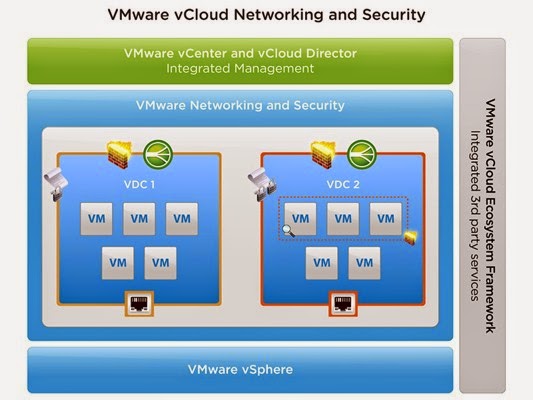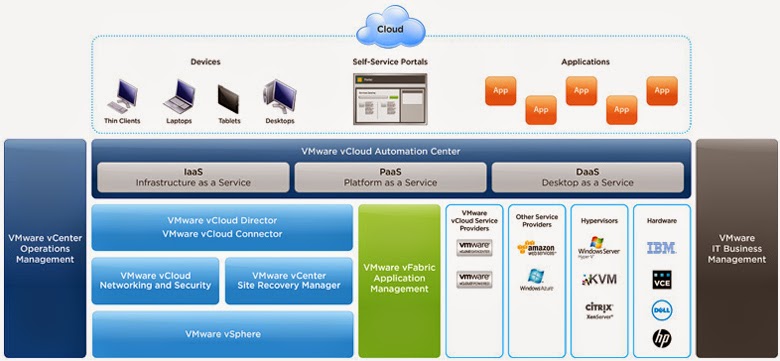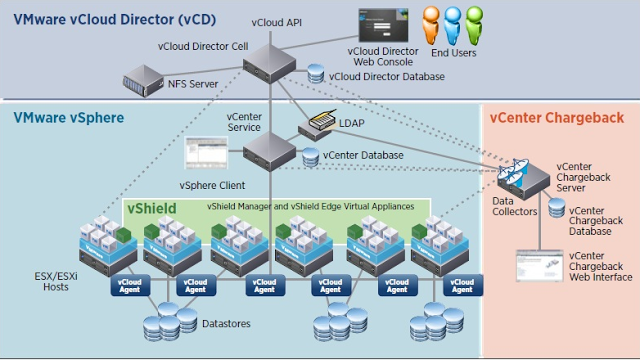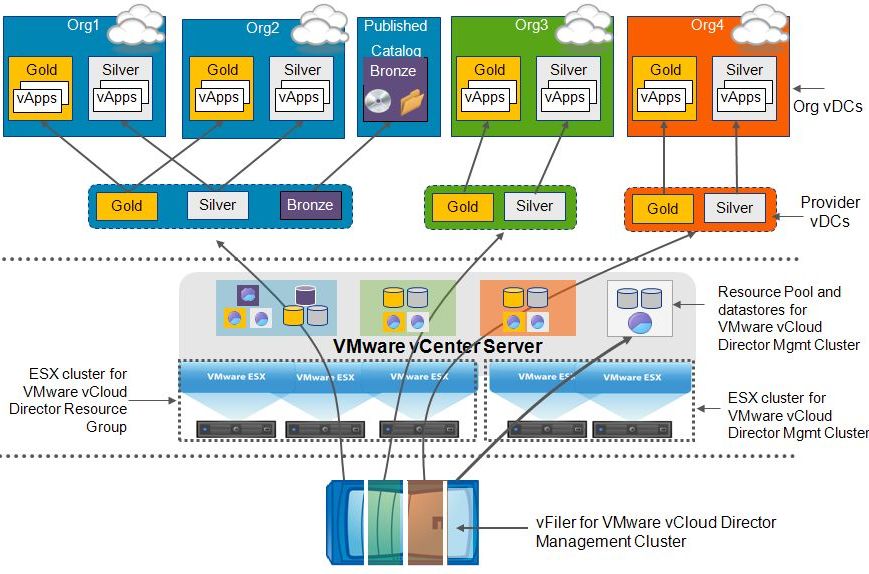Recently I decided to learn and implement vCloud Director in my Home Lab. Before proceeding it was important to have an overview of the components which makes the vCloud Director and the associated terms and terminology used.
There are plenty of information available on internet and I am including here some of the information which I found.
Understanding the components of vCloud Suite
The vCloud Suite looks like as shown in below picture. The suite is a combination of multiple products which is required to create a complete Cloud Infrastructure.
Graphic Thanks to VMware.Com
The suite can be broken into 3 categories to understand better what are the products that made up the suite and how they work and combine together. As shown in above picture we have 3 categories here:
1: Cloud Infrastructure: This contains the vCloud Director itself at top along with vCloud Networking and Security (vCNS) and SRM. At the bottom we have the vSphere Infrastructure (Esxi + vCenter). vCloud requires vSphere Infrastructure ready before any cloud product can be deployed.
VMware vCloud Director
vCloud Director is an abstraction layer, it allows anyone to come along and consume compute, memory, networking and storage resources without worrying about the underlying hardware or infrastructure. It enables that current buzz word Infrastructure as a Service (IaaS). Along with providing abstraction, it also allows consumers to have an on-demand self-service portal allowing them to provision there workloads when and how they want them.
vCloud Networking and Security
VMware vCloud Networking and Security (vCNS) is the software defined networking and security solution. It provides a broad range of services in a single solution, including virtual firewall, VPN, load balancing and VXLAN extended networks.
Graphic Thanks to VMware.com
Site Recovery Manager
SRM offers support for vCloud Director environment. In order to ensure all management components are restarted in the correct order, and in the least amount of time vSphere Site Recovery Manager will be used to orchestrate the fail-over.
Graphic Thanks to VMware.com
2: Management Layer: The management layer contains the products that help you manage and maintain vCloud Infrastructure. It includes vCloud Automation Center (vCAC), vCenter Operations Manager (vCOPS) and vFabric Application Director.
vCloud Automation Center: VMware vCloud Automation Center enables you to rapidly deploy and provision business-relevant cloud services across private and public clouds, physical infrastructure, hypervisors, and public cloud providers. It provides
- Unified cloud management that seamlessly spans private and public clouds that are based on VMware or other technology
- Fast delivery of virtual, physical and cloud-based infrastructure services that meet the needs of both the business and individual users
- Simpler management of multi vendor virtual desktop solutions through automation and orchestration of tasks across the tools and infrastructure required to deliver the virtual desktop service
- Intelligent resource management designed to help ensure higher utilization through placement, prevention and reclamation of resources across virtual and physical servers
Graphic Thanks to VMware.com
vCenter Operations management suite: This suite provides predictive capacity and performance planning, compliance and configuration management, dynamic resource metering, cost modeling, and report generation using the following components:
- vCenter Operations Manager: It enables administrators to monitor the performance of their environment, alerting them to potential issues before they become critical. This is an invaluable tool for capacity planning and optimization of a cloud environment
- vCenter Configuration Manager: It delivers capabilities fundamental to ensuring that virtualized and cloud computing environments are properly configured to meet operational, security and compliance requirements. VCM is a full-featured configuration-management solution that automates configuration management across virtual, physical and cloud environments. Enterprises can use VCM to continuously audit the configurations of VMware infrastructure as well as Windows, Linux and UNIX operating systems.
- vCenter Infrastructure Navigator: It enables application discovery, dependency mapping and management.
- vCenter Chargeback Manager: It provides accurate cost measurement and reporting on virtual machine usage. When it is used as a part of a self-service private cloud environment, business owners can now have complete transparency into and accountability for the services they are consuming
vFabric Application Director: it seeks to significantly simplify the process of deploying applications and updating those applications. vFabric Application Director works by allowing you to declare your application and its components and make a blueprint of that application. vFabric Application Director then integrates with the vCloud API’s to deploy your application into a private or public cloud.
3: Extensible Layer : This layer consists of following products:
VMware vCloud API
It ensures compatibility between public and private clouds. By using the vCloud API, moving from a public or private cloud to a hybrid cloud is significantly simplified.
As an enterprise moves to a cloud-based infrastructure, customers can amplify the benefits of virtualization and move selected workloads within their datacenter cloud or to one of the many vCloud-enabled public clouds in the VMware partner ecosystem.
This suite also helps an organization achieve a cloud model that is uniquely theirs—a private, public or hybrid environment precisely aligned with their individual business goals. When enterprises are able to deploy workloads in the best environment for their business needs, they increase agility without compromising security, reliability or governance.
vCloud Connector: VMware vCloud Connector can be used to move workloads between vSphere and private/public vCloud Director based IaaS clouds.
vCenter Orchestrator: VMware Orchestrator is a free vCenter feature that helps automate VMware vCloud Suite, vSphere and other virtualization management system processes. Orchestrator’s workflow engine can be used to automate bulk operations and create workflow processes for integrating existing third-party tools. It can be installed as a virtual appliance, a vCenter add-on or a standalone product for a Windows Server installation.
vCloud Director Components
A basic vCloud Director deployment consists of a number of components. These include the following:
vCloud Director
A single instance of vCloud Director is known as a “cell.” A vCloud director can be deployed from ova file provided by Vmware or can be installed on a supported operating system (OS). In larger implementations, multiple cells can be deployed with a front-end IP load balancer to direct end-user traffic to the correct cell.
vCloud Director Database
vCloud Director stores information about managed objects, users and other metadata in a database. The current release of vCloud Director supports Oracle Database and Microsoft SQL Server for database platforms. In cases where multiple vCloud Director cells are deployed, all cells can communicate with the same database.
VMware vCenter Server
Each vCloud Director cell can connect to one or more vCenter Server instances to access resources for running workloads. Each attached vCenter Server instance provides resources, such as CPU and memory, which can be leveraged by vCloud Director.
vSphere Hosts
VMware vSphere ESXi hosts provide the compute power for vCloud Director. vSphere hosts are placed in groups of resources, such as clusters or resource pools. These groups and their associated storage are then made available to vCloud Director.
vCloud Networking and Security Manager
vCloud Networking and Security Manager provides a central point of control for managing, deploying, reporting, logging and integrating vShield as well as third-party security services. Working in conjunction with vCenter Server, vCloud Networking and Security Manager enables role-based access control and separation of duties as part of a unified framework for managing virtualization security.
The below image from vmware.com shows all the components which made up a vCloud director:
Terms and Terminology associated with vCloud Director
Provider Virtual Datacenter
A provider VDC is a logical grouping of compute and storage resources. The provider VDC groups together a set of vSphere hosts and a set of one or more associated datastores. This logical grouping is then made available for consumption by organizations. Provider VDCs can leverage the Storage Profiles feature of vSphere to provide multiple classes of storage to differing organizations.
Organizations
One of the key capabilities of a vCloud Director private cloud is secure multi-tenancy. The organization concept is one of the key building blocks of this. A vCloud Director organization is a unit of administration that represents a Collection of users and user groups. An organization also serves as a security boundary, because users from a particular organization have visibility only to other users and resources allocated to that organization. Organizations can be as simple as different functional areas inside a business or as complex as unique companies being hosted by a provider.
Organization Virtual Datacenter
An organization VDC is a logical grouping of resources from one or more provider VDCs that an organization is allowed to access. Depending on back-end (provider VDC) configuration and needs of the organization, one or more sets of resources backed by different provider VDCs might be present. This enables different performance, SLA or cost options to be available to organization users when deploying a workload.
vApps
A VMware vSphere vApp™ is an abstraction that encapsulates all of the virtual machine and inter-networking needs of an application. vApps can be as simple as a single virtual machine or as complex as a multi-tier business application. Templates can be created from a vApp to enable one to be easily redeployed multiple times by an organization’s users. These vApp templates can be shared among users in the organization or between organizations.
Catalogs
Organizations use catalogs to store vApp templates and media files. The members of an organization that have access to a catalog can use the catalog’s vApp templates and media files to create their own vApps. A system administrator can allow an organization to publish a catalog to make it available to other organizations. Organization administrators can then choose which catalog items to provide to its users.
Graphic thanks to bluevinifera.wordpress.com
Thats it in this post. In my Next post I will be covering my Lab Infrastructure Setup for vCloud Lab. If you are keen to explore more about vCloud Director and Components please see below the link section.
Additional Links:
What is vCloud Director- By Duncan Epping
vCloud Director Posts- By Chris Collotti
vCloud Director Concepts and Architecture- Vmware Education Services
vCloud Director Installation from Start to End- By Kendrick Coleman







Great series, can you advise what version of vCloud you are using and how it may differ from the Service Provider version? Also have you given any consideration to using NSX with your vCloud lab?
Hi Rob,
I am using vCloud director v 5.5 in my Lab. VMware is not offering vCloud Director anymore to customers apart from service providers. For building private cloud for yor organization you have to use vRealize Automation vRA (formerly vCAC)
Service providers who are using vCloud Director are using VCHS for offering cloud infrastructure to customers. vCHS have been replaced by vCloud Air now.
I am working on NSX integration with vCloud Director these days so stay tuned.
Hi Manish,
Thank you for sharing this valuable document. I am also planing to have some hands-on experience with It but as per your comment and even I tried downloading vCloud director v 5.5 but option is grayed out. So can you suggest me from where I can download the package to proceed further for Lab Setup.
Hi Priyankar,
vCloud Director is end of life and VMware is only providing it to service providers. Also VMware has released the vRealize suite for building a private cloud which contains components like vRA Appliance, vROPS etc. If you really want to try vCloud director then you can get it from someone who already have that software downloaded with them.